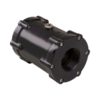The ceramic elements are used in high temperature air filtration for incinerators, biomass, and product recovery. Some of the industries these ceramic elements are used in include renewable energy, energy-from-waste, metals & mining, and product recovery.
The manufacturing facility of hot gas elements was originally developed for the aluminium industry to solve an issue of fires happening within the filter bag housing. Sparks were being carried over in the gas stream and setting fire to the carbon collected on the fabric filters. This company’s filters were developed using high temperature fibres and are designed to work in the same way as traditional fabric filters but with much higher temperature capability and resistance to sparks.







